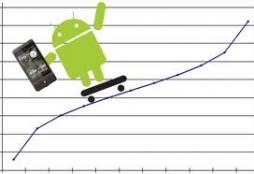cost
Posted by MelissaUlbricht on Sep 12, 2011
This year, Chinese company Huawei launched an $80 Android phone, the IDEOS, through Kenyan telecom Safaricom. According to sources, the phone has sold over 350,000 units in Kenya, “a staggering statistic considering nearly half of Kenya’s population lives on less than two dollars per day.”
We thought it important to take a closer look at this relatively low-cost device and the larger issues and questions that arise from it.
The Android Edge?
An article on Singularity Hub suggests that while affordability is a key driver for adoption, a larger issue with the IDEOS phone is the competitive edge of Android phones:
Posted by MohiniBhavsar on Sep 16, 2010
Mobile Learning for HIV/AIDS Healthcare Worker Training in Resource-Limited Settings data sheet 1874 Views
Abstract:
We present an innovative approach to healthcare worker (HCW) training using mobile phones as a personal learning environment. Twenty physicians used individual Smartphones (Nokia N95 and iPhone), each equipped with a portable solar charger. Doctors worked in urban and peri-urban HIV/AIDS clinics in Peru, where almost 70% of the nation's HIV patients in need are on treatment. A set of 3D learning scenarios simulating interactive clinical cases was developed and adapted to the Smartphones for a continuing medical education program lasting 3 months. A mobile educational platform supporting learning events tracked participant learning progress. A discussion forum accessible via mobile connected participants to a group of HIV specialists available for back-up of the medical information. Learning outcomes were verified through mobile quizzes using multiple choice questions at the end of each module.
In December 2009, a mid-term evaluation was conducted, targeting both technical feasibility and user satisfaction. It also highlighted user perception of the program and the technical challenges encountered using mobile devices for lifelong learning.
With a response rate of 90% (18/20 questionnaires returned), the overall satisfaction of using mobile tools was generally greater for the iPhone. Access to Skype and Facebook, screen/keyboard size, and image quality were cited as more troublesome for the Nokia N95 compared to the iPhone.
Training, supervision and clinical mentoring of health workers are the cornerstone of the scaling up process of HIV/AIDS care in resource-limited settings (RLSs). Educational modules on mobile phones can give flexibility to HCWs for accessing learning content anywhere. However lack of softwares interoperability and the high investment cost for the Smartphones' purchase could represent a limitation to the wide spread use of such kind mLearning programs in RLSs.
Posted by MohiniBhavsar on Aug 24, 2010
Improving Efficiency of Monitoring Adherence to ARV at PHC Level: Case Study of Introduction of Electronic Technologies in SA data sheet 2240 Views
Author:
Xanthe Wessels; Nicoli Nattrass; Ulrike Rivett
Abstract:
This paper presents a case study of the efficiency gains resulting from the introduction of electronic technologies to monitor and support adherence to highly active antiretroviral therapy (HAART) in Guguletu, South Africa. It suggests that the rollout of HAART to such resource-poor communities can be assisted significantly by the introduction of modified cellphones (to provide home based support to people on HAART and improve the management of adherence data) and simple barcoding and scanning equipment (to manage drug supplies). The cellphones have improved the management of information, and simplified the working lives of therapeutic counsellors, thereby enabling them to spend less time on administration and to devote a constant amount of time per
patient even though their case loads have risen threefold. It has helped integrate the local-level
primary health service provision of HAART with the kind of centralised data capture and analysis
that could potentially support a national HAART rollout.


